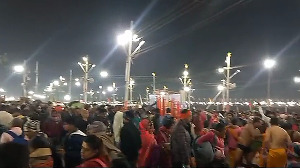Contrary to media hype, Finance Minister P Chidambaram's latest Budget does not mark a major break from past policies or set a new direction. Nor does it remotely address the huge distortions and imbalances in India's recent growth pattern. Chidambaram's decision to write off farmers' loans to the extent of Rs 60,000 crores is a belated acknowledgement of the gravity of the agrarian crisis, which has driven 150,000 farmers to suicide over the past decade. The loan write-off is welcome in and of itself. But it's nowhere near enough.
Sounds uncharitable or unconvincing? To appreciate why this isn't so, consider that the real problem with the economy in recent years hasn't been lack of growth. It is that other component of development, namely, equity -- growing income inequalities, sectoral imbalances and regional disparities. The United Progressive Alliance's last full Budget was to be "people-friendly" and correct these distortions. It has comprehensively failed to do so. Indeed, it continues with the neo-liberal policy orientation and will create more problems than it solves.
But first consider the much-touted Rs 60,000-crore write-off of farmers' debts, which has disarmed much of the opposition, and in particular, left the Bharatiya Janata Party confused, cavilling and nitpicking. This is undoubtedly the largest such write-off, much higher than the debt relief V P Singh attempted in 1990. But it pales into insignificance beside the revenue lost on account of various exemptions, rebates, incentives and concessions provided to corporate taxpayers and rich individuals.
In the last financial year alone, say the Budget papers, the government wrote off taxes and duties worth a colossal Rs 2.79 lakh crores in this manner! This amount is more than four-and-a-half times the Rs 60,000-crore one-time debt relief for farmers. This mind-boggling loss is equivalent to one-half of all taxes collected. It includes Rs 148,000 crores in customs duty exemptions, Rs 58,655 crores in corporate tax concessions, Rs 88,000 crores in excise duty concessions, and over Rs 38,000 crores in individual income-tax exemptions.
If some export-related subsidies and exemptions are added, the revenue loss would be a staggering Rs 337,000 crores, or 58 percent of actual tax collections. Yet, there was no furore, noisy debate, or accusation of scandal over this. Nothing could be a more eloquent comment on our distorted economic policy discourse!
Now, the Rs 60,000-crore farm loan waiver might appear to be extraordinarily generous. But first, the full waiver only applies to loans from commercial banks, regional rural banks and cooperatives taken by farmers owning two hectares (five acres) or less.
But 49.7 percent of such farmers borrow from local moneylenders, according to the Report of the Expert Group on Agricultural Indebtedness, released last July. Marginal farmers owning less than 0.01 ha are worse off -- and in greater debt. Seventy seven percent of them depend on moneylenders. So a majority of farmers are excluded from Chidambaram's waiver.
Second, the measure totally writes off only the loans of farmers owning 2 ha or less. It offers 25 percent debt relief to bigger landholders provided they repay the remaining 75 percent. But it's simply unrealistic, if not downright mean, to expect already highly indebted farmers to repay that 75 percent. They wouldn't have borrowed the money unless they were desperate in the first place.
Third, the 2 ha ceiling is reasonable for fertile irrigated lands. But a large proportion of our most heavily indebted and acutely poor farmers cultivate unirrigated, low-quality land with small yields. For instance, in the 'suicide belt' of Vidarbha, Saurashtra, Andhra's Rayalaseema, Rajasthan or South Karnataka, most cotton-growers practise subsistence dryland farming. A farmer owning 3 or 5 ha there is typically poor, and often distressed to the point of suicide. He/she stands to get virtually no relief from the Budget.
A far better alternative would have been to write off farmers' loans in inverse proportion to their holdings and yields in a graded fashion -- say, Rs 30-50,000 for the poorest, Rs 15-30,000 for the less poor, and a smaller sum for the indebted non-poor.
This would also have taken some of the burden off the nationalised and cooperative banks, which are likely to be given bonds or be paid in instalments and may not be fully compensated for the loan write-off. It's in nobody's interest to weaken the public banks' balance-sheets -- unless the hidden agenda is to set them up for privatisation by citing 'losses'.
In contrast to his miserly approach to farmers -- among the poorer of Indians -- stands Chidambaram's generosity to upper middle-class and rich income tax-payers, who comprise only 25 to 30 million people. Their income-tax rates have been slashed to a point where they are the lowest ever in Independent India and among the lowest in the world.
Under the new regime, a person earning Rs 5 lakhs -- thus belonging to the top two percent in the income pyramid -- need pay no tax at all if s/he uses all the available exemptions. And someone who earns Rs 10 lakhs -- and only 3 lakh Indians are in this category, comprising the top one-hundredth of the population -- will get away by paying a total tax of Rs 2.7 lakhs.
By contrast, most Western Europeans in a comparable income-bracket would pay 50 to 70 percent, and the Japanese even more. And India is a poor country which sorely needs to raise resources by progressively taxing the top 20 percent of the population in order to provide public services and redistribute incomes.
The tax regime has thus become even more regressive and iniquitous, and will put an additional sum of Rs 4,500 to 50,000 into the pockets of each of the already affluent. To match this, Chidambaram has neatly manipulated the supply side by reducing taxes on cars and two-wheelers, as well as luxury goods such as air-conditioners, refrigerators and washing machines. This will encourage profligate consumption, perversely raise aggregate demand and bloat up GDP -- thus creating a growth bubble, while adding to greenhouse gas emissions.
Chidambaram's failure is particularly glaring in six areas to which the UPA's National Common Minimum Programme gives high priority: the public distribution system, the National Rural Employment Guarantee Act, health, education, social security, and reduction of regional disparities.
Instead of beefing up and substantially expanding the PDS, he has raised its allocation by a paltry 3.5 percent. Forgotten is the goal of universalising the PDS to promote food security. The NREGA's district-wise coverage has been almost doubled, but its allocation has been increased by just 14 percent over last year's Rs 14,000 crores.
The Budget's outlay on health is only 17 percent higher than last year. But a steady annual increase of 35 percent is needed over several years to raise public health-spending from the present miserable 0.9 percent of GDP to the NCMP's target of 2 to 3 percent.
An important component of the National Rural Health Mission has seen its allocation decline by over 30 percent. Although the government promises to accelerate the Tobacco Control Programme, its outlay has been cut by 7 percent. And just as polio is spreading, support for polio eradication has been slashed.
The 20 percent increase in the education budget might seem impressive, but the bulk of it is accounted for by allocations to higher education, up 90 percent, and by a new stream of 6,000 'high-quality' model schools to be established, besides the Sarva Shiksha Abhiyan. What India needs most of all is greater investment in primary education and universalisation of school access for all children under the 86th Constitutional amendment on the Right to Education. In place of the necessary RTE annual allocation of Rs 53,000 crores, the government is proposing to spend only Rs 12,000 crores (off-budget).
As for social security, Chidambaram has wholly ignored the thoughtful recommendations of the Parliamentary standing committee on labour on social security for unorganised sector workers, which involve giving them rights and entitlements, not flimsy schemes to which they contribute a premium. He has merely repackaged existing schemes for health insurance and passed them off as new. The Budget shows a poor commitment to the Integrated Child Development Scheme, and fixes the pay of Anganwadi workers and helpers at an abysmal Rs 1,500 and 750 a month respectively.
The UPA had promised to invest substantially in backward areas and states, and take urgent measures to reduce regional and sub-regional disparities in infrastructure, agriculture, industry and social development, which are now acquiring explosive dimensions -- as the growth of Naxalism shows. The Budget betrays this promise.
However, the Budget has raised military spending by 10 percent at a time when the defence ministry is returning about Rs 4,000 crores unspent year after year. Including pensions, the defence allocation now stands at Rs 121,160 crores -- compared to a mere Rs 34,300 crores for education. This does not speak of a balanced Budget or healthy public priorities.






 © 2025
© 2025